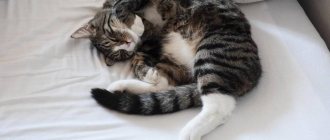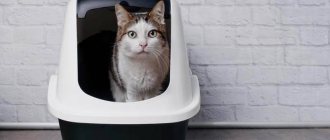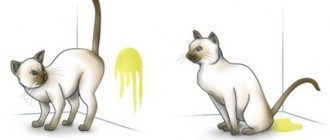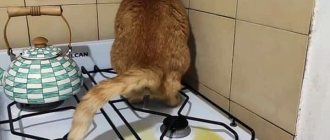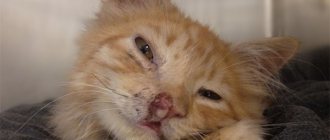Cats are considered very clean animals. And this is noticeable: they constantly wash their face and paws, clean their fur so that the fur coat is in perfect condition. In the same way, they are very demanding about their daily routine, about their possessions and toilet.
Usually cats go to relieve themselves 3-5 times a day. By observing the behavior of your pet, you will immediately understand when the cat is peeing and when it is marking its territory: when urinating, the animal squats down and then rakes it with its paw, “burying” waste.
If a cat has chosen your carpet on the floor as a toilet, then this is a very serious signal that should not be ignored. This behavior cannot be called normal. If the animal continues to do its dirty deeds on the carpet, you need to try to find the reason why. Perhaps, having found out this, you will not only save your property, but also the animal itself.
Why does a cat shit on the bed?
Before choosing training methods, it is important to understand why a cat stubbornly shits on the bed, avoiding the tray prepared for it.
Although some believe that this is how the pet expresses resentment or is trying to take revenge, in fact, this behavior is explained by other objective reasons:
Dirty tray
The cat has a dirty litter box
A special feature of cats is that they bury feces, which allows them to avoid attracting predators in natural conditions. Therefore, if the cat does not go into the litter box, but tries to hide its feces with the folds of the blanket, you should immediately check the cleanliness of the litter box. You must understand that your pet will not re-enter an already used container that acts as a cat litter box.
Problems with the filler
Problems with filling
An unfamiliar or unpleasant smell for cats with their sensitive sense of smell can serve as a deterrent signal. For this reason, the pet is able to stay out of its litter box after replacing the usual filling with a different brand. The same reaction is often observed after owners decide to completely stop using litter. To make sure that the cat started defecating on the bed for this reason, you need to return to the previous regime.
Consequences of stress
A common reason why cats adapt their owner's bed as a bathroom is a stressful situation:
A pet experiences negative psycho-emotional effects if it is transported to another premises. Adding another pet to your home can be a serious cause for concern. Fear is manifested and reinforced by physical punishment. Some cats react negatively to the appearance of a newborn in the house, which is where the family's attention is focused.
Diseases
The cat is sick
Sometimes cats poop while climbing on the bed due to illness. If you notice this behavior, you need to examine the animal. Usually, puddles on the bedspread indicate the development of urolithiasis. Due to pain when urinating, the animal strives for soft surfaces to reduce unpleasant symptoms. Feces appear on the bed at bedtime due to intestinal diseases of the cat.
Hormonal imbalance
Inappropriate behavior is often observed in animals during periods of hormonal fluctuations. Obeying natural instinct, during estrus the female marks her territory. Therefore, odorous traces will be observed in different places.
Elderly age
An aging cat often goes to the toilet in different places, including in bed, due to weakness and the presence of chronic diseases. Forgetfulness and loss of skills may occur. In such a situation, it is advisable for the cat to make a comfortable bed with his own hands, which is easy to wash.
Tray inaccessible
Tray not accessible
Sometimes the owner, deciding to change the location of the cat’s bath, rearranges its container. Very often the animal does not immediately get used to such changes. A puddle may appear on the bed if you accidentally closed the room in which the cat's litter box is located.
It should be borne in mind that most often they use a sofa, carpet, bed and other places that are unsuitable for kittens to defecate, as well as unsterilized animals. It is necessary to monitor a pet that has recently appeared in the house.
A cat shits on the bed - a folk sign
They say that people even have a poster stating that a cat that shits on the bed portends profit. According to another interpretation, this is a harbinger of the illness of one of the household members.
Recommendations
If a kitten was taken from the street, it had no restrictions in choosing where to defecate. Then you may not understand the prohibition against peeing in bed.
To wean a kitten in a week, read the recommendations:
- Make your animal uncomfortable when it is about to urinate on the bed. Scare him with aluminum foil in bed. A kitten will come, get scared by the rustling sound and run away.
- Play with your pet on the bed, they sleep together. Thus, you will understand that “a bed is not a bath.”
- Place your kitten's litter box in a special place in the house.
- To prevent the kitten from peeing, blot it with a damp cloth, spray water from a spray bottle on its face, and then immediately transfer it to the tray. When you finish your business there, pet and praise.
- Cats are repulsed by strong odors. Place a packet of lavender or any other strong-smelling ingredient on your bed. Avoid experiments with oregano and mint, they attract animals.
- The kitten may see its owner as its mother cat. When they are together, the child urinates in the sand. In the house you can switch to a soft bed.
- The tray should be comfortable, long and roomy enough so that you can easily spread it out.
- If the little kitten has managed to do its job on the bed, you will still have to bring it to the litter box, but you cannot show affection or kindness. Express disagreement with their behavior while leaving them to “think about their actions.”
- Until the animal has firmly learned that it only needs to go to the litter box, forbid it from sleeping in bed with you. A house and a sofa are suitable as an alternative to a bed. The toilet should be located next to them.
- The toilet needs to be made attractive, after cleaning it, treat it with a smart spray, then the kitten will be ready to go to the litter box again.
- Cats are clean and will not go into a dirty bathroom. A couple of sticky lumps may scare them away, change the filling or immediately remove sloppy lumps.
- Choose a litter that your kitten likes: clumping, absorbent, wood, silica gel.
- Sometimes the reason is that a particular blanket is attractive to the kitten, its texture is pleasant to the paws, especially if the tray provided by the owner is uncomfortable.
- Stress may be the cause. It occurs from moving, changing air, owners, or the appearance of other animals in the house. In this case, stroking and soothing herbal infusions will help. The doctor will tell you which one to choose.
- If the kitten begins to walk near the bed and urinate on chairs, sofas and armchairs, then this indicates health problems: cystitis, infections, problems with the urinary tract. At the same time, you will often pee, and sometimes you will not have time to run to the tray. You can find out why by contacting your veterinarian.
Preventive measures will not give the expected result if the kitten is sick or is bothered by changes that it does not understand. A patient and attentive attitude towards your pet in the face of any failure gives better results than physical punishment, screaming and threats. Pets are family members just like other family members. Comfortable living conditions, protection from diseases, a properly selected diet, a convenient and inexpensive potty will help to avoid problems and conflicts.
Additional Tips
Let's summarize briefly. Be careful and watch your pet. If you suspect any abnormalities in his health, go straight to the veterinarian. Try to block the places your cat chooses to vent. Family bed? Close access to the bedroom, etc. Carefully clean the places where the animal “goes”: the smell of urine will attract it here again and again. The tray should always be clean; if possible, move it to the least crowded, secluded place in the apartment. Finally, just ask for advice from an experienced professional, preferably a veterinarian - there may be reasons we forgot to mention in this article.
Original publication: My Cat Started Peeing on My Bed & Clothes! Why? Author: Jay Matthews Source and photo:
Getting rid of stains and odor
If the problem has already arisen, you need to get rid of the consequences - stains and odor. You can remove the smell with special means. If a cat shits on the bed, it is better to buy substances in advance that will remove “traces of the crime.”
If the problem arose unexpectedly, folk remedies will come to the rescue:
- The best way to get rid of acidic smell is vinegar. Diluted vinegar is enough to clean a fresh stain on furniture or add it when soaking clothes. Lemon juice is no less effective.
- Alcohol-containing substances will do an excellent job of removing wet stains on furniture or bedding.
- The combination of hydrogen peroxide (3%) and baking soda is excellent at removing both odor and urine stains and should not be used on dark, delicate fabrics.
- A solution of potassium permanganate will remove odor well, but it should not be used for light-colored fabrics.
It is advisable to take the affected mattress for chemical treatment.
How to stop a cat from pooping on the bed: proven methods
It is not difficult to train a small kitten to use the litter box. But if an adult cat suddenly changes its habits, or the animal is taken from the street, only those who show patience and love will succeed.
The owner must show the cat that he is against pooping anywhere and take care of cleaning:
- dirty floors are instantly washed and disinfected;
- you can use an odor remover;
- dirty shoes are thoroughly cleaned and put away.
Many cats urinate in one litter box and defecate in another. In this case, the problem can be solved in the simplest way: just place two containers next to each other.
If the cat is left alone for a long time, you will have to buy another potty, because this animal will not go into a dirty container.
Sometimes it is enough to change the brand of stuffing to the one the cat is used to. If there is a need to accustom the cat to a different filling, the change is made gradually, mixing the new brand with the old one in ever increasing proportions.
After making sure that the animal is healthy, you can apply educational measures:
- give a treat every time the cat goes into the litter box: to positively reinforce correct behavior;
- place dishes with food where they are dirty - cats do not go to the toilet where they eat;
- in cases where “not a single bowl is enough,” you can put dry food in places that have been thoroughly washed with urine or feces.
If the cat is accustomed to walking on any object that can be temporarily removed (rug, chair), then it is better to remove it completely or not let the cat into the room. But it cannot be guaranteed that, having stopped pooping in the wrong place for some time, even for a long time, the cat will not use this thing as a toilet again after some time.
For a small kitten, a very effective method is to soak a rag in his urine and place it in the litter box. The smell will guide the animal to the right place. The same can be done with an adult cat brought from the street.
A good way is to place the litter box where the cat starts defecating, gradually moving it to where the owner needs it. Often the cat obeys or does not notice the change in the position of the potty. But sometimes you have to put up with this and constantly move the tray to the corner chosen by the animal.
You can make the location chosen by the cat inaccessible:
- cover it with something that is better unpleasant for the paws;
- cover with a strip of double-sided tape;
- make inaccessible (block, cover).
Sometimes it is effective to create an uncomfortable situation at the moment when the cat is sitting in the corner of his choice (unexpected appearance, applause). But the animal always understands that it is doing bad things and tries to do it when no one is around. The owners will have to look, and perhaps more than once.
To prevent a cat taken from the street from marking the entire floor, you can collect its scent on a porous rag (by rubbing it on wool, for example) and spread its pieces across the floor. Then the animal will understand that this is its territory and that it does not need to be marked.
To prevent pets from spraying gonad secretions and urine in the apartment, males are castrated and females are sterilized. But if this is done too late, when the behavior has already been corrected, the operation will no longer remove the tags. Your veterinarian will help determine the correct age for this procedure.
An animal that shits in the wrong place in order to find a sexual partner can simply be given the opportunity to satisfy its instinct, and silence and cleanliness will return to the apartment.
We recommend viewing
Why do cats change their sleeping places? Why do cats act strange when you scratch the base of their tail? How to keep cats away from bird feeders
Cats love clean and tidy litter boxes, and most cats clean up their own poop. But if he doesn't clean regularly, your cat will let you know by urinating on your clothes.
To avoid this behavior, regularly scoop out the litter from the toilet and clean it thoroughly, removing old litter and wiping with unscented soap about every two to four weeks. Your cat will appreciate this and show that she doesn't pee on your clothes.
What other measures to take
In order to understand how to correct the animal's behavior, it is necessary to establish the reason why it began to use the entire house as a toilet. When this motive is established, it is not necessary to punish the cat who has shit; sometimes you can return him to the litter box using gentler methods.
What to do for skeptics
All people, regardless of whether they believe in omens or not, must remember that it is necessary to accustom a kitten to the litter box from the first days of life. However, teaching a four-legged pet to take care of its natural needs in a specific part of the house is only half the battle. Next, you need to make sure that the litter in the cat's litter box is always fresh and the tray is clean, otherwise the cat may start looking for another litter box.
If everything is in order with the tray, and your four-legged friend has long been accustomed to it, but suddenly begins to mark the owner’s bed or other objects in the home, the following will help to prevent him from doing bad things:
- If the animal is sick (diarrhea or disease of the genitourinary system), it should be shown to a veterinarian, who will prescribe treatment for the cat. As a rule, the recovered pet returns to the tray on its own.
- If a person offends a cat and takes revenge on him for something, it would be good if the owner tried to understand why this happened. Perhaps the cat felt that the owner’s love for her had decreased due to the appearance of a new family member (child) or another animal in the house. In this case, the owner of a four-legged pet should pay more attention to it for some time. You shouldn't punish your cat for having shitty shoes or a blanket on the bed. It will be enough to defiantly ignore him after each incident. And, conversely, after any proper trip to the litter box, pet the cat and treat him with his favorite treat.
- If the purr poops all over the house because he is already old and simply does not have time to reach the litter box, and the owner loves him so much that he does not want to put him to sleep, then the solution may be to install another cat litter box in a different place. An older cat can be easily trained to use this type of litter box by placing anything that smells like her urine in the spare tray.
- The worst option is when a young male cat urinates on the furniture and belongings of the owners, marking his territory. In this case, it is sometimes impossible to return it to the tray in the usual way, even if all the marked places and objects in the house are treated with chemicals that repel strong odors. Castration is the only way to wean an animal from bad behavior.
Organize the tray
Would you like us to guess what you and your cat have in common? That's right: you both hate dirty toilets and bathtubs. Remember that there should always be enough litter in the tray, otherwise cats will simply refuse to use it. The reason is simple - cats are quite squeamish and are afraid of contact with urine. If the tray is dirty, it means that a clean cat will go and choose another place that is comfortable, in her opinion. Recipe: clean the tray daily, add litter if necessary, and do a general cleaning once a week using mild detergents. Do you have several cats? Then each cat gets a separate tray (plus one extra).
Puddles or marks
Why the cat shits on the bed is now known. How to find out what is left on the bed: puddles or marks?
Labels are defined by the following characteristics:
- Puberty period. It begins in animals at different times, depending on the breed. Puberty occurs at the age of 6-9 months. This is when cats begin to mark their territory;
- Cats in heat may also begin to urinate in the wrong place;
- They recognize traces by smell, unlike urine, it is specific and very clear;
- If you take a piece for analysis, it turns out that these are just pheromones, and not a drop of urine;
- You can identify these puddles or tracks by observing exactly how the cat makes them. Raise the tail vertically, extend the hind legs and spray pillows and blankets with a strong stream. Markings on cats indicate that they are ready to breed.
Signs of cat puddles:
- The puddle is much larger than the signature spot, it is not a few drops, but a large wet spot on the bed;
- To urinate, the cat lowers its tail, sits down, and spreads its hind legs;
- Puddles may not have as strong an odor as footprints.
- A puddle cat will try to “bury” the puddle by covering it with a blanket or crumpling up the bed.
Depending on whether they are puddles or traces, it is convenient to deal with their appearance in different ways.
Label
Urine
Tendency to leave puddles and marks
Some particularly fussy breeds, kittens, unsterilized cats and older people are prone to puddles and marks. Each of them has its own reasons, so the approach to solving the problem must be selected individually.
Capricious breeds
The most capricious breeds include Siamese cats and their closest relatives from the Siamese-Oriental group. Such cats have a very delicate mental organization. They are easily offended or stressed. Therefore, the reason for their bad behavior is usually explained by psycho-emotional factors.
Physiological features
Age plays an important role. A kitten who is not potty trained will make mistakes for quite some time. Raising them will take a long time, so you just have to be patient.
“Accidents” in older cats occur due to urinary incontinence or memory impairment. As they age, they forget the location of the litter box, often get lost in the family apartment due to visual impairment, and do not always have time to go to the toilet.
Constant hormonal surges in unsterilized pets can only be suppressed through castration. Without surgery, they will constantly mark the bed and other objects in an attempt to attract a mate.
Territory marking
Cats very often use their own urine to secure a certain territory. Moreover, the risk of such behavior increases sharply when the cat is alone in the house. Young cats “mark” their territory by spraying urine wherever they please, while female cats leave “marks” to attract the attention of the opposite sex. How does this usually happen? Cats usually turn from behind to the object that interests them and “shoot.” Unspayed (unspayed) cats are much more prone to this behavior. At the same time, you can really see how much your pets value the place where they live!
How to stop a cat from peeing in bed
Having determined the reasons for the appearance of puddles or marks on the bed, it is easier to understand how to make sure that the cat does not shit on the bed. It should be noted that you cannot show aggression, use brute physical force on the animal, or stick your nose into a puddle. This will aggravate the situation and increase the animal’s stress. You need to control yourself. The only acceptable punishment is to explain to the cat in a stern voice what he is doing wrong. Animals will understand perfectly well that the owner is unhappy.
All dirty pillows, bed linen, blankets and bedspreads should be thoroughly washed, stains and unpleasant odors removed. Then dry everything. If possible, take the mattress to the dry cleaner. Make your bed with clean sheets
Since cats are dependent on smell, it is important to get rid of it
Next, it is recommended to inspect the tray. Rinse it even if it is dry and clean. Sometimes drops of urine remain on the tray, which the owner does not notice. The animal, sensing the smell, refuses to write and is poisoned in search of a new place. If after changing the filler or tray a puddle appears on the bed, you need to return everything as it was. If a small child or another family member appears in the family, cats should be given enough attention. They will be stressed by any changes and will be jealous of it. The cat needs to be picked up, stroked, and treated to treats more often. Also give animals sedatives of plant origin. The preparations are natural and will not harm the cat’s health.
If all the described external reasons do not affect a specific situation, it is recommended to consult a veterinarian. Perhaps the animal suffers from some kind of disease and therefore urinates in the wrong place. The veterinarian will take the necessary tests and perform an examination. These measurements will help determine whether the animal is sick. Treatment will also be prescribed in more serious situations - surgical intervention.
If a young kitten is being mischievous, you should approach the situation with patience and understanding. Take your child to the litter box more often. The best time is immediately after sleep or food. If the kitten turned out well, it is recommended to praise him and treat him with a treat. Constantly reminding your baby where to defecate will bring results over time.
Another recommendation concerns urolithiasis, which often affects spayed and neutered cats in particular. It is necessary to periodically do rapid tests and visit a veterinarian. Regular examination will allow you to promptly identify the first signs of the disease and begin treatment on time.
Cats are demanding, jealous of the appearance of new family members and other animals in the family. The reason for the “unexpectedness” in the owner’s bed may also be diseases or age-related characteristics of his body. Animals need the support and help of their owners. An attentive attitude will bring more benefits than nervousness, aggression and physical punishment.
